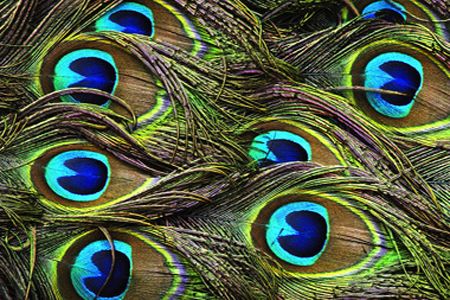Harnessing The Power Of Peacocks To Make Colorful Images

(ISNS) -- The gloriously colored, iridescent feathers of the male peacock aren't what they seem on the surface. They look that way largely because the feathers contain nanometer-scale protein structures that break up incoming light waves, recombine, and reflect them as rich, vibrant colors.
Scientists at the University of Michigan think they have a technology that emulates this process to display pictures without chemicals or electrical power.
Eventually, the technology could replace the displays now used on smartphones, tablets, and computer screens, with strikingly high definition.
"All the different colors can fit into a corner of a pixel in your iPhone," said Jay Guo, professor of engineering and computer science and lead author of the paper in Scientific Reports.
Although researchers are currently only able to produce static photos on a glass surface, they hope eventually to produce dynamic pictures on other surfaces.
As a peacock moves around, its tail colors appear to change. That's because its iridescent feathers reflect different colors, or wavelengths, of light, at different angles.
But while peacocks use feathers, Guo's team uses metals, which interact with light in more complicated ways. They create metal structures with nanoscale grooves that produce iridescent colors, but also trap the light so that viewers can see the intended colors from all angles.
Sign up for the Live Science daily newsletter now
Get the world’s most fascinating discoveries delivered straight to your inbox.
The trick, Guo said, was to get light to enter grooves much smaller than the wavelengths of light. By etching the grooves a certain length it will absorb that color. By doing this, the researchers were also able to beat something called the diffraction limit, in which they can create picture elements, or pixels, smaller than half the wavelength of the light, to generate detailed color.
The researchers also are using plasmonic behavior, said Peter Vukusic, a physicist at the University of Exeter in England who was not involved with Guo's research. Roughly speaking, plasmons are ripples of electrons on an electrically conducting surface. Light shines on a metal, and its plasmons can reradiate specific colors. Some of the colors in stained-glass windows at cathedrals like Notre Dame are produced by the plasmons in tiny particles of gold reflecting light and producing an extremely vivid color.
That is not how most color is produced now.
When you look at a picture of a red flower on paper there is a pigment chemical that absorbs each color -- green and blue for instance -- and reflects the red so you see only that color.
On a television screen, smartphone, or the result of an inkjet printer, pixels are arranged that absorb red, green and blue from white light, in combinations that produce a color image.
To simulate the peacock effect, the Michigan researchers combined the techniques. They etched nanoscale grooves on a piece of glass with the same technology used to etch computer chips. Each groove was made just the right size to absorb a certain color, and then the coated the glass with silver. When they shined light on the glass, the grooves created the color image. To demonstrate the process, the researchers reproduced an image of the Olympic rings, with resolution so good, each full color ring was about 20 microns across, smaller than half the width of a human hair.
"If you want to produce simple prints, this is not going to be the cheapest way," Guo said. "But the technology is green; it doesn't require any chemicals."
Guo that said prints made this way would be permanent, and that the colors would not fade.
Most displays on electronic devices such as tablet computers or laptops use backlights, which require power from either a battery or electrical outlet to keep showing the image. A reflective display using this plasmonic technology would require no such power, and is brighter. The reflected image from this process can even be polarized, meaning it could be bright and clear if you look at it one way, but disappear entirely if you turn it 90 degrees, polarized in the same way some sunglasses reduce glare.
The potential polarization means it could also be used in cryptography or security where images can be invisible, or produced on credit cards or currency.
How this would work with a dynamic display is not clear, Guo said.
"With the right design this opens up the playing field so more appearances, optical effects, devices are in reach -- in theory," Vukusic said.
Joel Shurkin is a freelance writer based in Baltimore. He is the author of nine books on science and the history of science, and has taught science journalism at Stanford University, UC Santa Cruz and the University of Alaska Fairbanks.
Inside Science News Service is supported by the American Institute of Physics.












